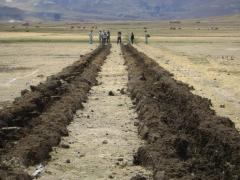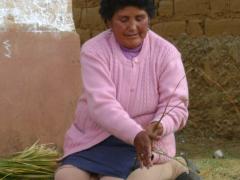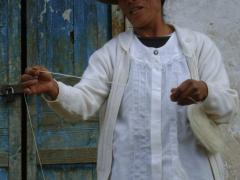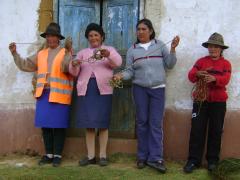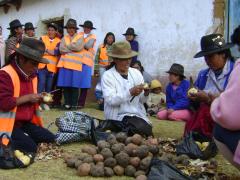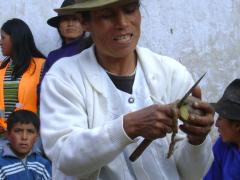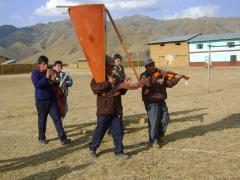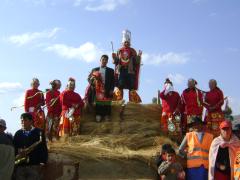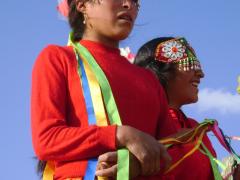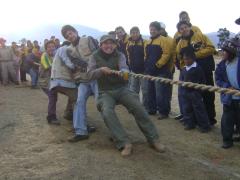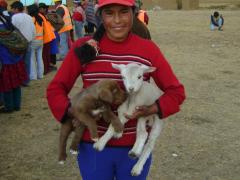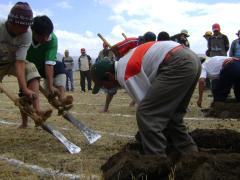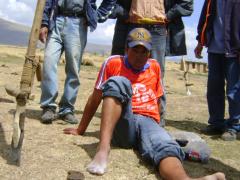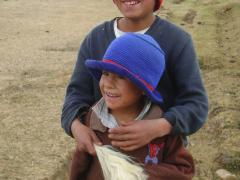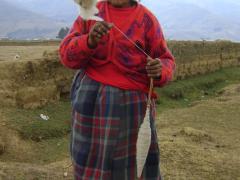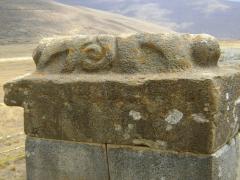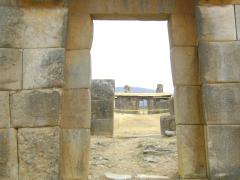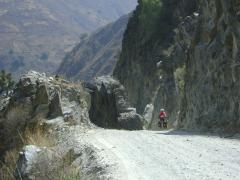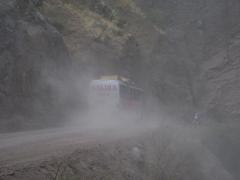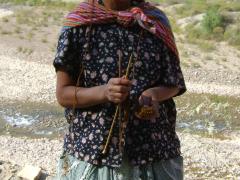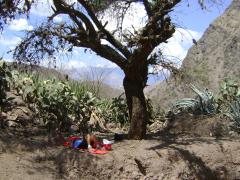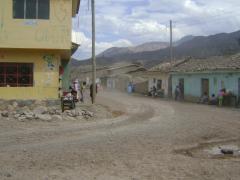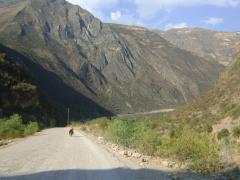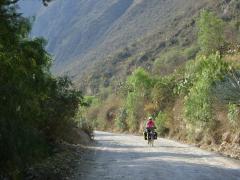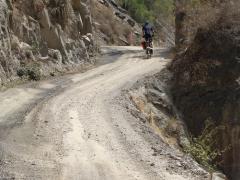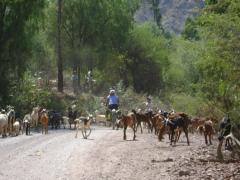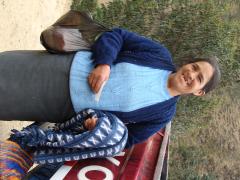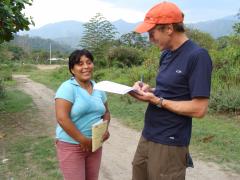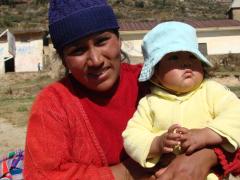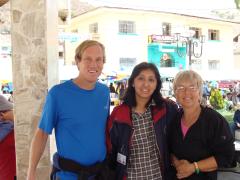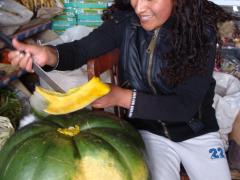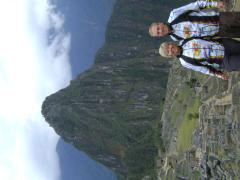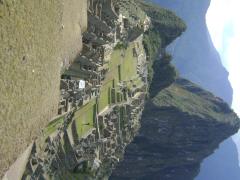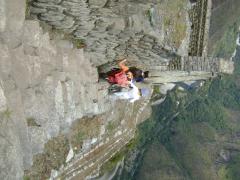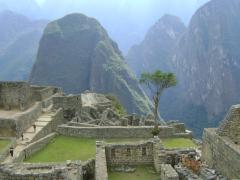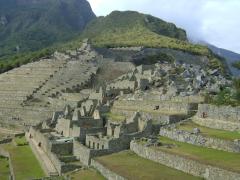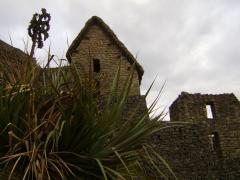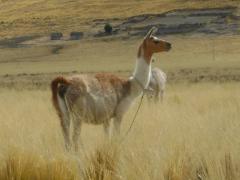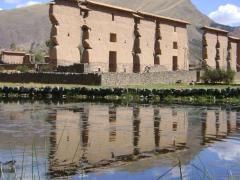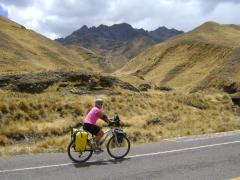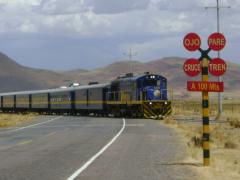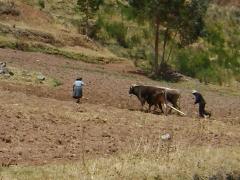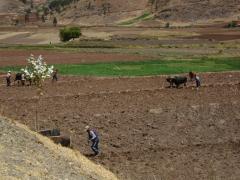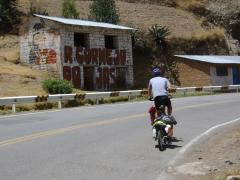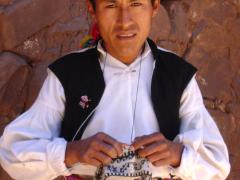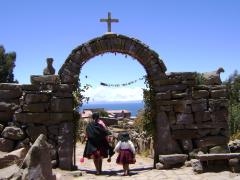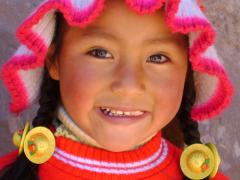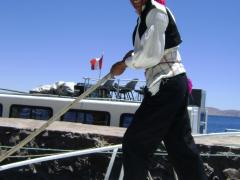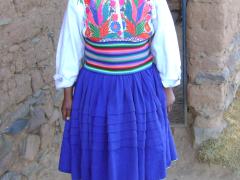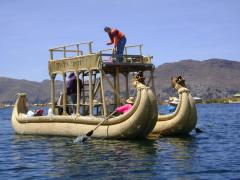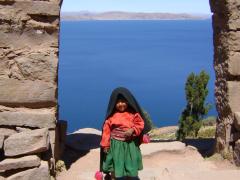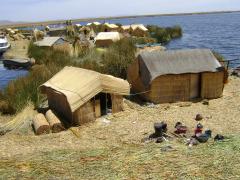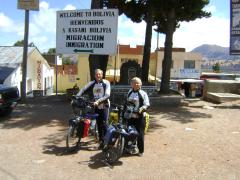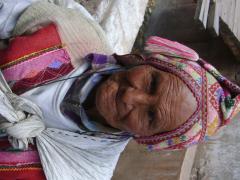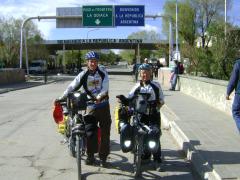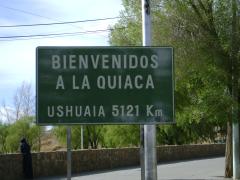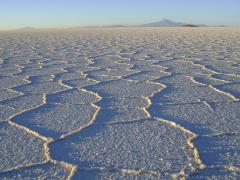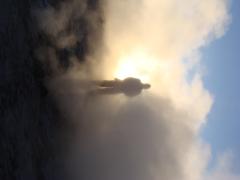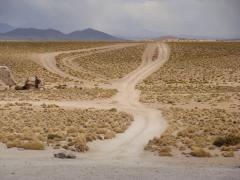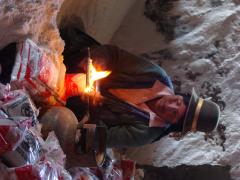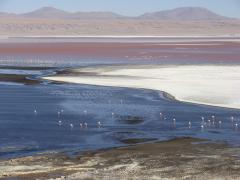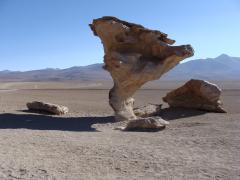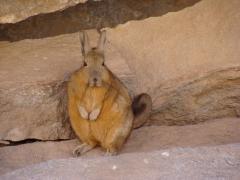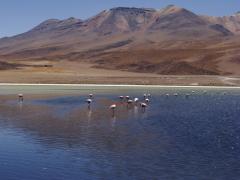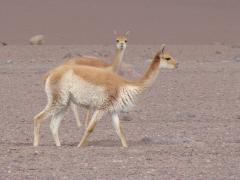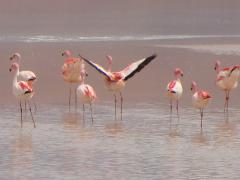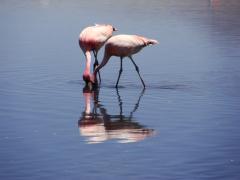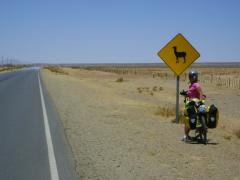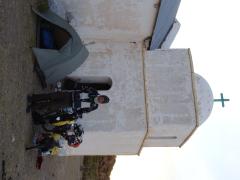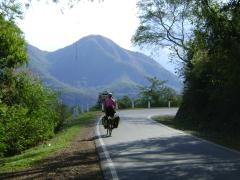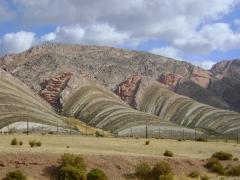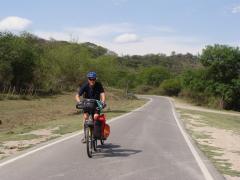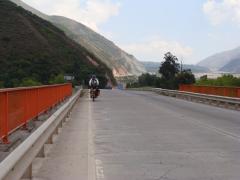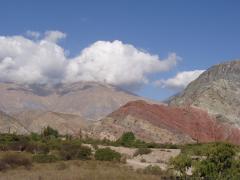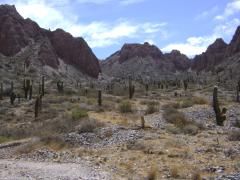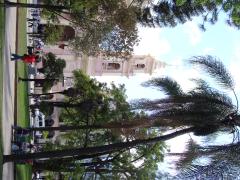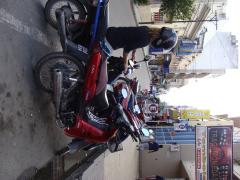Trip Blog
Celebrations and Ruins in Huánuco Pampa
Visiting wonderful archaeological sites along the way has been one of the many joys of traveling through the Americas. Occasionally it requires a good hard hike to get there. We had no intention of visiting the Peruvian ruins of Huánuco Pampa (also known as Huánuco Viejo) but while we were riding through La Unión, the local pride in this beloved site got our curiosity going. We could have taken a 5am bus up to the 3700 meter plateau but we didn't want to get up that early, we needed some exercise on our day off from riding, and it's far more direct to walk, so we headed up the narrow canyon to visit old Inca Ruin, Huánuco Pampa.
I was very impressed on how treacherous this route was but it was a major walking thoroughfare for the local people. Slippery rubble lined the route the first first few hundred meters. It seemed not to bother the locals as they knew this was the shortest route from the high pampa flat plateau down to the town of La Unión 700 meters below. It was a beautiful sunny morning and just the right temperature for this adventure. We greeting everyone as we passed by. "buenos dias!" to the shepherds and the cowboys leading the horses and donkeys laden with recent harvested goods. "Hola" to the school children riding donkeys or hiking down with plastic backpacks on their tiny backs. "Como esta" to the woman riding the horse 6 hours from her farm high in the mountains. The most amazing was the very ancient woman who trekked this arduous route with her cane. It took her an hour to make her way down this steep, steep trail with the beautiful woven shawl she used as a backpack to haul her goods up and down. I stopped to talk to her for a few minutes (and catch my breath). Looking into her face, I saw an Inca women of tremendous age, eyes worn from years of living off the land, a few brittle teeth stubbornly stuck inside her withering jaw, leathered skin, and hair as bristled as an old discarded brillo pad. When we parted, she looked up into my face, took my hand and gently pulled me toward her as she gave me the most memorable hug I have ever received. She was Mother Earth, and I was touched by her forever. She smiled and told me to have good travels.
When we reached the flat pampa after an hour of what seemed like straight up, the landscape was completely different because we were up on the plateau above the valley. Adobe houses and stone walls divided the dry, high tundra. Sheep, cows, horses, goats wandered in groups followed by the shepherd. I wondered how such an overgrazed land could support so many animals. There was signs stating a project or two was working in the area to save the environment and the soil. I think they have a lot of work to do to revive this hard-packed land. After another hour of walking the Inca-like trail, we reached the entrance of the ruins of Huánuco Pampa, also known as Huánuco Viejo or Huánuco Marca.
In the wide open field in front of the 800-year-old Inca site was a huge gathering of local people. Some kind of festival was going on. We stood to the side, watched the goings on and soon many kind people came up shook our hands and welcomed us to the Potato Festival. This was the time of year villages in the area celebrate the planting of the most important crop of Peru, the potato.
We stayed all day and watched the festivities. Most of the day was filled with competitions between people representing their village or neighborhood. First was the turning of the soil. Two teams of three men raced each other down a 100-meter row preparing the earth of planting. Two men would break the soil with special shovels while another man would turn the huge clump of earth. Barefooted and in unison the teams worked as they sliced the into the ground, pushed the tool two feet deeper, turn the clump to the side, remove the shovel, back up and start again. In 15 minutes the two teams completed their 100 meter row. One team was faster but the other team had dug a prefect trench void of clumps. The competitors dropped down to the ground with exhaustion. The crowd cheered, clamped and jumped around with jubilation. The judges inspected the rows. They both won, one team for speed and the other for perfect work.
The second competition was slingshot accuracy. A special hand-woven sling which held a colored rock was twirled around clockwise and the rock was released toward a distant target. The crowd roared with each attempt. Peruvian shepherds use this technique to either herd wayward animals or to scare off approaching predators. The target was missed by everyone during the first round so the target was moved 10 meters closer. One man won in the third round, eventually hitting the target. The third competition was similar but was based on distance. There was even a woman who competed in this. She was great but not good enough to win the furthest throw.
We took a break from the competitions and visited the ruins. These ruins seemed to be a huge hotel for travelers between Cuzco, Peru and Quito, Ecuador, the South and North capitals of the ancient Inca empire. The most impressive part was the perfectly cut rocks which fit together like a puzzle without any cement or grout. Some of the rocks had 12 perfect angles as they were cut in a "L" shape. How they got these huge stones to this site from distant quarries is one feat. The other is how they cut these without metal, without modern tools. The huge dormitory structure had different stone work which was the first we have seen. It uses a rosary design to build the walls. A large round boulder is set surrounded by smaller boulders forming a rose like design in the wall.
After touring the site we headed back to the center of the local village to watch the rest of the days event: Potato peeling, wool spinning, rope braiding and tug-of-war competitions. (the archaeologists did an awesome job against the strong hard working farmers but came in second) Then the local band marched in, followed by several magical characters and young women in traditional costumes dancing and singing traditional songs. After invitations and prodding Randy and I joined the center dance which was the opening ceremony for the 3 day festival of Potato Planting.
I am amazed at how so many events in Latin America are public events and open to all. The people of Peru are such generous, open people who share in their culture and riches with complete strangers like us. They seemed honored that we would stay all day and join in with the festivities.
Here are some videos of the wonderful events:
- Digging the potato rows for planting
- Rope-braiding competition
- Spinning competition
- Potato peeling
- Inca maidens dancing
- Dancing and Music
If you're reading this on hobobiker.com, you can click on any of the pictures below for a full-size view and a slideshow, with captions.
Riding the dusty Rio Mantaro from Huancayo to Ayacucho
We have been riding in the low desert river valley lands at about 7000 feet elevations. The last 4 days have been been very, very hot, dusty, remote, and buggy. We are very dirty. We are taking time out of today's ride to clean the grit out of our teeth, escape form the high temps. and enjoy the pleasures of civilizations for half of a day in Huanta. A bed, a shower, Internet and food other then pollo frito (fried chicken) and arroz (rice).
It is an amazing land. We dropped down 3000 feet and everything changed from cold to hell. It reminds me of some of the landscape near Tucson, Arizona where various cacti adorn the barren landscape. I am amazed how people can eek a living out of land so barren, devoid of resources and forgotten by everyone including the government. This land once was terrorized by a group of rebels called the Shining Path (Sendero Luminoso) but they have long ago abandoned this place and left it to the vultures. Very few buses, cars or trucks passed by us in this rugged, dusty, forsaken place. The land is too dry to support sheep but we did encounter shepherds herding goats along with pigs, a few cows, and donkeys. It is so strange to see women in skirts, blouses, fancy hats, a babies slung on their backs tending to their herds and knitting some kind of clothing or such. The women all through Peru knit. They stand or sit and just knit. Women in other places in Latin America weave but in Peru they hands are very busy knitting away.
The people here in the middle of the Peruvian highlands are very friendly, very friendly. Hundreds of times a day a day I hear "Hola, Mami" or "Buenos dias, gringita. ¿A donde Vas?" translated as "hello, mommy" or "Good day, where are you going friend Gringa?" . I respond that we're going to Cusco (an unthinkable distance for them) and then to Bolvia and Argentina (which either blows their mind or bores them, depending on how well they studied geography in school). As we climbed out of one river valley, a woman and her 14-year-old daughter walking down the dirt mountain road kindly inquired about our trip. "A donde van? " The mother had such a strength but gentleness to her. Her laugh was one of the most beautiful laughs I have ever heard. After telling her "A Cusco, despues, Bolvia y Argentina" and answering dozens of other questions, she wanted to know how hard it was to go the the United States to live and work. She is the kind of person I would want to sponsor and bring back to the USA. Perhaps someday I will. She had one last question. Her daughter had been holding a cloth up to her mouth with a grimace on her face the whole time we talked. I thought she might have been shy but no I was wrong. Her daughter had a hole in her mouth, actually in her teeth and she wanted to know what she could do for her. The girls upper lips and gums where swollen like she had been stung by bees and developed a reaction. We told her that she needed a dentist. I really think she did not know that a dentist helps with problems with the teeth. Or perhaps she couldn't even imagine the amount of money that would be required to visit one. She might have come from a remote village where there is no dentist and she herself appeared as she had never visited a dentist. Most of the mother's bottom teeth were black and rotting in place and it was obvious she never had the resources to visit a dentist.
I saw the pain in the girls face as I closely examined her problem. The swelling was obvious and she needed treatment. I gave her two baby aspirins, some water which she drank with gusto and some teeth-numbing paste I have carried in the bottom of my first aid kit for two years. I showed her how to apply it to the affected area which she mimicked but applied it to all her gums. No harm. We suggested she seek the help from a dentist. I hoped there was a dentist in the tiny village a few kilometers below. I never thought I would be a traveling medicine women but I was glad we where able to give a little help to the delightful woman and her daughter. All day I thought of the bewilderment of the two as what to do about the pain and perhaps infection.
We ended up camping several nights along our trip from Huancayo to Ayacucho. Once was in front of an abandoned adobe complex. As it was to late in the day and we where not going to make it 10 kilometers to Anco, we stopped to ask the old couple sitting on the stairs of one of the unoccupied house. We asked if we could camp here which the old man responded by showing a place behind half destroyed wall. It was perfect. It would protect us from the dust kicked up by the occasional passing vehicle. After we set up camp, we prepared a meal of instant mashed potatoes, instant noodles, tuna fish, curry and a touch of olive oil. I finally realized that this old couple who had not moved far from the steps, also did not live here. They laid out a couple of blankets on the hard ground and settled in as night creeped in. There was not lights here, and a creek flowed through the property. We learned they lived up the mountain, an hour and one half walk from this campsite. They were resting here also. I realized they had not eaten so I gave them some of our dinner. I wondered what they thought of the improvised meal. If they did not like it, which was very possible, then the two skinny dogs and cat that hung around would finally get to eat. In the morning, I saw the old man feed some chickens and never saw them again.
Another night we stayed in Mayocc, a small town that has next to nothing. Indeed a very poor town. They had three small hospedajes (cheap hotels). One was up stairs in a rough concrete structure with no paint. The dust from the unpaved road below billowed dust into every nook and cranny of the rooms. The other hostel had no bathroom and everyone went out to the back field with the billions of nasty gnats to take care of their private needs. Nope not for me. The third was full but Carlos let us camp in back. (Big thanks to Carlos and his sister) The best part of this place was it was not a dust bowl and it had a bathroom and a place to shower. Well sort of. It was more like a concrete outhouse with three stalls and a flimsy vinyl sheet covering each of the door entries. It was perfect except it had no water. The town had no water most of the time except for maybe a half hour in the late afternoon and another half hour in the early morning. Somehow the town worked around this and manages to get by. We hung around in the late afternoon in the shade and avoided getting eaten by the nasty little bugs. Using what precious water they had stored we took a shower using our 10 liter water-bag with a shower head attachment in the privacy of the concrete outhouse. I was in heaven as the dust poured off me down into the floor drain. And later when the water came on, I managed to hand wash our grimy clothes. A room with a single bed and a single light became available. Instead of setting up our tent we slept in one small bed for for a cost of three dollars. The young employee who worked at the hotel/restaurant slept outside our door on the concrete floor near the stairs. He must have given up his bed to us.
A little later I wandered the town purchasing the food for the next day's ride: Yogurt, bread, tuna, crackers, peach juice. Returning back to the hotel, under the light of a street lamp, a volleyball came flying my way. I love volleyball and so do the Peruvians. I think it is the biggest sport in the country. I put my bag down and joined in a game with 5 young children. We played in the middle of the dusty road, with an imaginary net. The girls against the boys. Every time the girls scored a point against the boys, the my two little teammates run up to me and gave me a bear hug as they jumped up and down yelling "Point for Peru". Many people stopped and watched us playing. One of the girls told me to use my "Arma" which I guess is a technical move in Volleyball. But as far as I understood in Spanish arma is a word for weapons. I told her I did not understand because I do not have any weapons. "Yo no tengo Arma" The towns people laughed with delight. It was a really funny moment which I thoroughly enjoyed. All was good with life: Simple moments makes for simple joys. No complicated lives with cable TV, Internet, telephone, lights, bills, etc. Just a genuine moment playing volleyball in a dusty forgotten part of Peru with some new little friends.
If you're reading this on hobobiker.com you can click on any of the pictures and see a full-size view and a slideshow.
You can see all the photos from this stretch of road on flickr.
Working with Kiva and Microfinanzas Prisma in Huancayo
One of the objectives of our trip was to spend some time volunteering for various organizations, and getting to know the area and meeting the people that way. We volunteered with Friendship Bridge and Kiva.org in Guatemala last year, and Kiva was kind enough to set up a task in Huancayo and Tarma, Peru. Our job was to visit loan recipients, interview them so that we could write update their profiles on Kiva, and verify that the loan data were all correct.
Two marvellous young women hauled us all over the back country of Peru searching out the selected Kiva borrowers. In Huancayo we took more buses in one day than we could have imagined, visiting what seemed like dozens of little villages outside the city. In Tarma they arranged a 4-wheel-drive and a driver to haul us all over creation to find the clients. In one case we spent about an hour and a half climbing one incredible road up to a remote village... and then found that the woman was not home! However, we eventually found her husband and he was delightful.
We found out a few things in our few days of volunteering:
- Microfinance is helping lots of tiny businesses in Peru.
- People like you are providing lots of capital for these tiny businesses through Kiva.org
- The microfinance provider Microfinanzas Prisma is handing its clients well - we found a few discrepancies, but they were tiny, and all the clients we visited were real people, not any kind of fraud.
Some links you'd like to find out more about microfinance:
- A hobobiker article about Microfinance
- Try out Kiva.org
- Read our other articles about Kiva, Friendship Bridge, and Microfinance
FAQ: Don't you get tired?
This is an attempt to answer a Frequently-Asked-Question, both at home and on the road: Don't you get tired?
I think there are two different questions being asked. The first is, "Don't you get physically tired riding all that way?". The short answer to that one is: Yes, we get physically tired, and we rest and that solves it.
But the other question people are asking us is, "Don't you get tired of it? or bored?". And that one has a more complicated answer.
Yes, we sometimes do get tired of it. Sometimes the road is the same for a few days. Or the scenery and challenges seem to remain the same. Or the challenge seems a bit too much for a while.
Our standard prescription for a bike tourist that gets discouraged is easy: Rest for some time, and it won't seem so overwhelming. We know of one cyclist who, after riding all the way across Europe in record time, suddenly started feeling like all the people in the country where he was riding were looking at him wrong, like they were out to get him. We think he was tired, and should have slowed the pace, or stopped to rest a few days. But he was on a flight home within a couple of days, having aborted his trip. Cyclists often don't know how tired they really are.
Another thing that's important is to avoid dwelling on the ultimate destination. Our ultimate destination is Ushuaia, in Tierra del Fuego, at the bottom of South America. That's still a long way away. We have to keep focused on our short term goals, because looking that far down the line will make it all seem impossible. (We're having a bit of trouble with this right now, after all this time on the road. We're thinking about the destination.)
And it's terribly important to seek out good routes to ride. The fast ones are often killers. We could go down to the coast of Peru and Chile and ride as much as 60 miles (100 kilometers) per day, I think. But when you just ride on a fast highway and the scenery doesn't change, you end up riding like a zombie, and the enthusiasm leaves. Too much flat road, with unchanging scenery, or difficult traffic, will wear you out for sure.
We do take vitamins in an effort to keep up our attitude, and we do listen to books from audible.com on our MP3 player along the way, if traffic permits. This makes the hours go faster.
But right now, despite all this, we're struggling with where we're at and how far we have to go. And we've had a terribly interesting and rewarding time in Peru. It's perhaps the most stimulating and interesting and friendly place we've been. But some of the roads have been the hardest too, with more dirt in this part than we had experienced in any other country. I'm thinking about how far it is to Ushuaia (the bottom point in South America). And I'm thinking about the fact that we probably can't make it there before their winter sets in in April of next year unless we start taking more buses than we have.
Tomorrow we're going to take a bus that will get us over one of the most difficult dirt-road sections of the entire trip. It's 15 hours (and about 150 miles!) from Ayacucho to the pavement that will lead us to Cuzco. I'm always reluctant to get on a bus, being a bit of a purist, but we decided to do it. (We took a bus from south of Huanuco to Huancayo also... Nancy wasn't feeling well and it was just good to get that stretch over with.)
So we have lots of advice for other people, but we're hoping that we can manage this tiredness or anxiousness and keep the trip on track.
In Cusco!
We have just arrived in Cusco, Peru. We will play tourist for a couple of days before going to the famous Inca ruins, Machu Picchu. We took the bus from Ayacucho to Cusco. During the 20 hour bus ride, the views where tremendous from the low river valleys up to the high mountain passes of 4300 meters. The road was mostly dirt, dusty and rugged. The central part of the Peru highlands are desert and dry, bone dry. The rainy season will start sometime near the end of September but for now it has been months without a good rain. I was very glad to be riding in a bus and not having to ride the terrible roads over five extremely high mountain passes and down to the hot dry river valleys. There was no in betweens, either it was up or it was down.
There was one bad thing that did happen. My camera got stolen in the market in Ayacucho right before we where going to catch the bus. I am so bummed and mad. We had our bikes fully loaded and we stopped to buy some bread. I was right next to my bike and Randy next to my bike. I was buying bread and some one distracted Randy with a stupid question which he turned to answer. When I returned to my bike, the camera was gone. There were so many people around and not one person saw what happened. The worst part of getting my camera stolen is the timing. It was one week before we go to the famous ruins of Machu Picchu. I will miss that 10x zoom.
The good news, all the photos backed up except for one day which is nothing in the scheme of things. (thanks to Randy who had just backed up the all the photos on the cameras the day before.)
Security and Bike Touring in Latin America
The first thing to think about when discussing security is safety on the road. We're far more likely to be hit by a car or truck than to be held up by a robber. And probably most accidents don't even involve a car. None of ours has. So route choice, careful riding, a good mirror, and the like are more important than thinking about weapons and robbers and assaults.
But we need to think about those things. They happen here, and so here is our thinking.
Some of our advice is easy: Learn as much of the language as you can so you can communicate about security and understand what people tell you. Don't get involved with crooks or narcotics dealers. Pretty obvious.
Then:
- Ask the locals about the security situation and listen to them.
- Don't listen to stories from other travelers unless the events happened to them personally. Only very rarely should you heed anything you hear about a country from people in another country. They just have built-in fears.
- When camping, (at least from Mexico to Bolivia) either camp with a family or in a town if you can. Or if you're stealth-camping, camp where nobody will ever know you were there.
- Try to find out about outrageously insecure areas (the road from San Cristobal to Palenque in southern Mexico, or the town of Paiján in northern Peru come to mind)
- Never leave anything unattended, even if it's locked. There's kind of a philosophy in the Latin world that if you leave something unattended you didn't really want it. An unlocked bike watched by a little boy that you just met in front of a little store is immensely more secure than a bike locked with a fancy lock and left on the street. A shopkeeper will often watch the bike, and then it should be fine.
- Know and understand the difference between petty thievery and assault. You may get something stolen off your bike sometime, or you might get pickpocketed, but that's not really all that bad. Avoiding assault is the real issue. You do that with knowledge and planning.
- Hotels are really pretty good for security. We almost always try to put the bikes in the room, and not leave them where somebody can walk by and fiddle with them. If they are out where guests pass by, we remove all the accessories from them. We also remove the accessories when we're likely to be surrounded by a lot of people, on bus trips, in city centers or the like. Remember, though, that the hotel workers do go into your room, and if you leave valuables, they can disappear. If you have a stash of cash, make sure it's very well hidden. We did have an episode of this type at a hotel in Honduras.
- Keep your stuff organized, battened down, and where possible, within your view. Things that are loose or behind you might disappear. We had a tool disappear from a seat-bag in a little village where we were surrounded by a crowd.
- Traveling together with a partner and staying close to each other is a huge security win.
- Be harmless. Harmless people are less likely to have problems.
- Trust people. You usually can. Our philosophy is that if you've looked somebody in the eye, they're not the ones that are going to go after your stuff. It's the ones you didn't see that are the problem.
- The police are your friends. Be aware that corruption happens, but it probably won't happen to you. Ask them about the security situation. We've camped at police stations too.
- Have money and debit cards in more than one place, so that you have a chance of recovery if something does happen to you.
- We use a laminated photocopy of our passports for almost everything. It doesn't work at border crossings, but it works for almost everything else. This lowers the likelihood of losing your passport or getting it stolen.
Update: The morning after I wrote this, Nancy's camera was stolen outside the market at Ayacucho, Peru. It was a distraction deal: I was watching Nancy's stuff, but a guy created a diversion, and when I looked back, the camera was gone. What went wrong? 1. We went to the market with our gear to get some bread. We shouldn't have gone anywhere near the market with our gear. 2. Nancy didn't have the camera well battened down in her bag (she left the bag open) and she showed it. So we live and learn.
If you have anything to add to this, please leave a comment!
Machu Picchu
Every tourist in Peru must go to Machu Picchu, the legendary lost city of the Incas. So we went! We took a tour of the Inca's "Sacred Valley" and then took the train to Aguas Calientes, the jumping off point.
In the morning we got up at 3:45am to start the hike up to the site, because we wanted to see the sun rise on the mountains. It was a good solid hike up the path (more sane people take the [expensive] bus up there). And it was delightful to see the light come up on the really steep green mountains all around us.
Up on top we took a tour (not the best) and then Randy hiked the steep staircase-like trail up to the top of the pointy mountain that's in the back of every Machu Picchu picture, Huayna Picchu. Nancy got out her watercolors and spent hours drawing the site.
The best part of the whole thing was just sitting and looking at the panoramic view of the site with Huayna Picchu in the background. You could just look at it forever.
We've set off on the bikes again and we're now 2 days southeast of Cusco on our way to Puno and Lake Titicaca.
Pavement! Cusco to Lake Titicaca
We finally got started riding again and headed south from Cuzco on delightful paved road. It was paved all the way! Sometimes it was smooth, sometimes rough. Sometimes there was a good shoulder, sometimes not, but it was delightful. The traffic was moderate, the weather was good, the one climb (over a 4300 meter or 14,100 foot) pass was gentle. We took 5 days for the ride, and while we were tired when we got to Puno and Lake Titicaca, we were sure happy with the road.
We got to visit one ruin, Raqchi, that we'd never even heard of. But the guide was good and it was an interesting place, constructed in 1300 A.D. or so by the Incas apparently primarily as a food storage location, as there are more than 150 storerooms that were used for grain. But there were lots of artisans there too, as there still are today.
One town where we stopped, Calapuja, showed us hospitality beyond anything we have seen to date, even with all the kind people we've met in our 12,000 miles. We had heard that there might be a little hotel in the town, so we went into the plaza and sat down for a rest before we started figuring it out. We were just sitting there, and a little girl came over and said "Are you going to stay here tonight"? We said "yes", a little confused. We figured maybe she was the daughter of the hotelkeeper or something. But moments later a fellow came by on a bike and said "follow me - you'll be sleeping in the church". We followed him, and he opened up the rectory section of the church, with running water, a flush toilet, a kitchen, and beds! It was amazing. We've had people take us home before, but nothing quite like this.
On the last day we finally spotted Lake Titicaca. Lake Titicaca is the world's highest navegable lake, at 3800 meters (12,500 feet). It's quite large, very blue and spans a big piece of the border between Peru and Bolivia.
The Islands of Lake Titicaca
Lake Titicaca is a massive lake, the highest navigable lake in the world at an elevation of 3,812 meters (12,507 feet). Both Peru and Bolivia share this deep blueish-green lake with several islands on the Peru side and several on the Bolivia side which are inhabited by indigenous people who mostly speak Quechua and Aymara, two languages that date from the Inca empire. A visit to the islands is an important part of visiting this natural wonder of the world.
We took a two day boat trip to three islands on the Peruvian side of Lake Titicaca: Uros, Amantaní and Taquile. We first visited the Uros Islands, which in reality are dozens of floating artificial islands. Each island is made of reeds which are bound together and maintained by the inhabitants. People actually live on these small floating islands in reed houses. Not only are the houses and the islands themselves made of reeds but they make boats out of them too. Is is fascinating to see all the different designs of boats made solely of reeds. The people of the islands used to make a living from fishing, but this has replaced by tourism on most of the islands. The women wear incredibly bright neon-colored clothes which glow against the yellow reeds and blue lake and pastel-colored sky.
The second island we visited was Amantaní. The people make a living hosting visitors which provides an opportunity to experience this remote Quechua culture. There are two pre-Inca ruins on this island in which we visited one on top of the hill called Pachamama (Mother Earth). All along the amazing worked-stone trails people of the island lined the path selling their handicrafts of knitted Peruvian hats, scarfs, woven clothes and hand made bags. Young children followed us playing the tube flute in hopes of getting a little tip. I tipped them a pencil each to leave us alone. It was rather bothersome after awhile. Randy even had a dream that night -- on the way to the outhouse in the middle of the night a vendor was out there selling some kind of handicraft.
There are no hotels, cars, horses, cows, or dogs. The people who live on Amantani live a simple life. They haul all the goods on their back, up and own the steep inclines. All spare land is terraced and they grow potatoes, wheat and vegetables. We watched a small group of people planting potatoes. Instead of plowing with machinery or oxen, I watched two men acting as oxen pulling a wooden plow through the brown earth, followed by a women directing the blade through the freshly prepared soil. Three other women sat to the side sorting the starter tubers and chatting in Quechua. One had a beautiful book of the history of the island which she would happily sell to us for $10.
The island has a generator for electricity but is used only for short time during the early evening. Other people use solar panels to generate electricity, which with increased energy prices is quickly becoming a top choice. One of the children of our host family did homework under the single light for less then an hour. We ate by candle light and shared this meal with one other couple from Germany who enjoyed the experience of getting away from it all. All the three meals we ate were vegetarian and very simple: soup, rice and steamed vegetables, bread, cheese and tea. We stayed upstairs in a two story adobe house which was built right at the edge of the lake. During the evening I sat out on the balcony watched the lake, the stars, the moon and the sleeping sheep. I had never seen the stars and the moon shine so brightly. I felt at peace and went bed at 9:00.
The third island, Taquile, again required a huge climb up to the village. What I liked about this island was the traditional dress worn by the men, beautiful colors which complimented their bronze skin and handsome physique. The men on this island knit and the women weave, both of which are intricate and colorful. In 2005, "Taquile and Its Textile Art" were honored by being proclaimed "Masterpieces of the Oral and Intangible Heritage of Humanity" by UNESCO.
The people of Taquile seem to live a together as a tight knit community. Taquileños run their society based on community collectivism and on the Inca moral code "ama sua, ama llulla, ama qhilla" (Quechua: do not steal, do not lie, do not be lazy). It seems to work as far as I can see they live in peace, without yelling, hitting, drunkeness and time to think and look out on to the lake. They have enough food to eat and water to drink and all seem to be educated Not too bad of a life, living on a remote island in Peru.
Entering Bolivia!
We entered Bolivia today. We asked cyclists already in the country whether they were sensing any unrest or finding any problems, and none of them were. So we decided to head on in. And even the news shows that all the issues have been in the eastern part of the country, which was far from our route anyway.
The one hurdle we had to cross that we haven't anywhere else on our trip: We had to get a visa! There was a gob of paperwork and $135/person to be paid for the privilege. Bolivia started this program (exclusively for US citizens) several months ago in the interest of "reciprocity". It only makes sense. If Bolivian citizens want to go the US, they have to jump through all these hoops (and far more, really). And we knew about this hurdle for many months.
We had thought we could get the visa cheaper ($100) Bolivian consulate at the last city in Peru, Puno, but when we showed up at their doorstep they told us they were out of visas and didn't know when they'd come.
For other cyclists, our friend Andrew wrote a great article about how US cyclists get a Bolivian visa.
How much does your bike cost?
Ever since we got to Mexico we've had to deal with the question in every little village: "How much did your bike cost?" It's embarrassing and difficult. Our bikes are ordinary mountain bikes, middle-of-the-road affairs, but they cost around US$1000, which is more than a year's income for a Guatemalan family. It's more money than most campesinos in the countries we've ridden through will ever see. So if we say "1000 dollars", they go into shock. I don't think it makes the bikes more likely to be stolen, but it's just a terribly uncomfortable thing to discuss.
In the past we tried: "About 2 weeks' salary" (very unsatisfactory to all, since it's an honest and open question. Some friends suggested lying and saying "$200" or something. That doesn't seem too good either. We've tried "It was a pre3sent; I don't know." Also unsatisfactory. Everybody knows we know.
But recently one answer has been very successful. We say "It's our custom not to talk about prices and expenditures." They immediately nod their heads and drop the question. Es nuestra costumbre no hablar de precios. Since I was raised not to talk about such things, it's absolutely true. And people really respect it since they're used to respecting other people's customs. Anyway, a recommended response!
Peru Wrapup
Pictures from southern Peru and Northern Peru are up... And our route maps and elevation profiles are all up-to-date as well.
Peru was a delightful and challenging country for bicycle travel. The people are warm and open and cry out "Gringo!" from every field and household. (This may be rude in "gringo" terms, but it's just friendly banter from most Peruvians. Who knows why everybody does this in Peru!)
It was also a hard country. We climbed to passes as high as we've ever been (4700 meters, over 15,000 feet) and suffered endless dusty dirt roads. The toilets (or rather outhouses) (if they existed) in rural areas were often of the "squatter" type, not the "sitter" type, where you put your feet beside a hole and aim at the hole.
The country is incredibly beautiful, with striking snow-covered mountains, green rice paddies, huge rivers, and everything in between. And, of course, it has Machu Picchu, which has to be one of the world's most beautiful places.
It was cheap most of the time, except around Cusco and Machu Picchu, where they have the squeeze of the tourist down to a fine art.
Some price examples:
- Hotels: US$5-10 for the two of us. Sometimes surprisingly good. Sometimes not so.
- Internet: The cheapest we've seen yet, almost invariably US$0.33/hour. Normally good quality and speed, too.
- Meals: The "set meal" or "menu" is cheap - usually between $1 and $3. It's usually a soup of some type, followed by rice with chicken or meat or some such, with perhaps a drink as well.
- Bus: We went several hundred miles on bus. We spent US$20/each for a two-day journey. A fancy bus with fold-down seat (into a bed) from Trujillo to Lima was about $30.
Cusco was another matter. Just getting into Machu Picchu costs $40. The train to get there (only a 1.5 hour journey) costs US$65 roundtrip at the least (from Ollantaytambo). The guides are expensive. The bus from Aguas Calientes (at the foot of the mountain) costs something like $20 for a short ride. (We walked up.) However, the prices for various treks in the area seemed fair, like US$180 for a 5-day all-included hike, including porters for gear.
We rode 1218 miles in Peru, and were on bus and potato truck for another 826 miles.
Teetering on the edge! Help us with our decision
Update: See what we decided here.
We need your help! Please vote and help us decide what should be our next step.
After two years and 3 months of traveling by bicycle, we are tired and want a change or need a change. Our not-so-young bodies are complaining of the day and day out pounding of the roads of South America. But more than that our not-so-young minds are so full of what we've seen and done they don't seem to want any more. We have pedaled over 21,000 kilometers (13,000 miles) and bused, boated or hitched another couple of thousand kilometers. We have climbed many 4000 meter (13,000 foot) passes, pedaled to incredible beaches, passed months after months of farmlands filled with scattering of adobe homes and animals, sweated in the deserts, swatted the swarms of nasty bugs, visited cities, towns, tiny villages, churches, ancient ruins, museums and talked with thousands of people from many different walks of life. The turbulent economy has rocked us all. Even though we are in Bolivia, one of the poorest countries in the Americas, the financial situation in the US has affected our travel funds.
We are turning to of our loyal followers for support and advice in our moment of need. Please write to us and let us know what your advise to us would be.
Here are our options, as we see them:
End the trip here in Bolivia and head back home. We've seen enough and enjoyed it all!
Take a bus or plane to lower elevations and continue on and re-valuate at a late time.
Take a a month or two off somewhere in Argentina where it is spring where as Denver, Colorado is entering into fall and then into winter. Argentina has wonderful beef and great wine at cheap prices. We can re-hone our computer skill remotely and at the end of the two months we can start the restart are careers or cycle on.
Fly to the bottom of Argentina and start cycling north and call it quits when we want.
Fly to the lakes district in Chile, recharge our batteries, paint pictures for a while, hike the remote parks along the coast of southern Chile and mediate on our future.
Head home for a period of time to be with family, to work, rebuilding our courage and continue the trip some time in the indefinite future.
Or just suck it up and ride the ride.
Please use the poll below to tell us what you think. And send us a note if you want to.
Our Plan: To Uyuni and the Argentine Border by Bus
Thanks to all of you for your wonderful advice! After a week of resting in La Paz, Bolivia, here's what we have decided to do:
Tonight we're taking an all-night bus to Uyuni, in southern Bolivia, where we'll see the amazing Salar de Uyuni. After a few days there we'll take a train or bus to the Argentine border and ride south on the bikes to Salta, Argentina. In Salta we'll probably take some more time off, perhaps a month or so. Randy will try to pick up some work on the internet doing some web development, and Nancy will be refreshing some of her skills and doing some more drawing. Then we'll probably head south on the bikes and continue the ride.
Thanks so much for your care for us and for your encouraging comments!
Love,
-Randy and Nancy
Riding around Lake Titicaca and into Bolivia
We rode from Puno, Peru to La Paz, Bolivia mostly along Lake Titicaca where the high-altitude lake reflected silver sunlight off the deep blue-green water. During the ride we saw villages harvesting reeds to make into mats, individuals making fishing nets, groups of people preparing the earth for the planting of potatoes, with mostly human power or oxen, but a few had the benefit of using tractors. The first night out of Puno, we outraced a tremendous storm and dove for cover in Ilave after riding 35 beautiful, flat miles. It was so good to be in a hotel room, dry, and safe from the blasting winds and pounding rain which lasted for most of the late afternoon and evening. The next day when we awoke the sun was shinning and the skies were clear. We rode another 49 miles enjoying vast open altiplano which was a wide open valley of dry flat fields. The closer we got to the Bolivian border the more we saw sheep and llamas grazing in the open valley. We even stopped for a photo shoot at the market in Juli where the livestock market was full of sheep and llamas. I saw live sheep hauled up on to the roofs of mini buses and lashed down. I watched as they stuffed live llamas inside the buses. I found it amusing to see a big bunch of live giant sheep on top of a van and a heads of llama sticking out an open window as the buses called colectivos drove past us. I was glad I was not one of those animals.
We stopped for the night in the last town in Peru called Yunguyo before we crossed into Bolivia. To our delight the town was celebrating the fiesta of its patron saint. Over twenty groups paraded around the town, playing incredible Andean music complete with panpipes, traditional folklore dancer in elaborate costumes and followed by marching bands. All the groups were from this one town and they all must have been practicing all year. The main plaza had bleachers for the spectators and the music went on for 4 days. While we were there the music continued all night and a new parade started at 6:00 in the morning complete with many marching band and dancers. Women and men, danced and drank beer during this celebration which I found ode because I have not seen alot of women drinking in South America. The young teenagers danced and played their instruments with passion and celebrated immense intensity.
Entering Bolivia was calm for the most part. I rode past the immigration check-in point by mistake. I was an illegal in Bolivia. When I passed all the houses, business, waiting taxis and was riding toward the countryside, alone without Randy, I figured I had missed a turn and went back to check in. One immigrations officer was keeping an eye on me. I found Randy waiting with our paper work and the astute officer. When we paid our $135 dollars each and turned in all the paper work, the man stamped our passport and declared that now we were no longer illegals.
After a short 5-mile ride, we entered into the lovely town of Copacabana. The weather was perfect, with a strong warming sun and the warming affects of the lake. The town has a huge, absolutely huge Moorish style church, dedicated to the Virgen of Copacabana. Why a small town would have such a wondrous church is very puzzling, but it does create a center master piece of this sleepy town.
We stayed in the Hotel Sonia, which I highly recommend for the budget minded traveler who wants TV, hot water, sunny rooms, good beds and a 5th floor terrace with extraordinary view. I visited a dozen hotels in Copacabana and most are either very expensive or very run down. Hotel Sonia is thumbs up in my book.
After two nights stay in Copacabana, we pedaled the remaining two days to La Paz. We arrived on Sunday which is the best day to ride into a huge city of over one million two hundred people. We took the autopista down to the center of town. The drop of 600 meters snaked down a few kilometers and took us from 4100 meters to 3500 meters into the historic center of town. Even though the sign on the highway said bicycles prohibited, the toll gate attendant motioned us down the freeway. There was mammoth shoulder which I rode down on. Because of some chunks of concrete and other missing parts, I cautiously made my way down to the San Francisco plaza, while Randy whizzed down in the traffic lane, going as fast as the all the cars and buses. Luckily there was little traffic and we both entered into La Paz fairly relaxed.
The main reason we went to La Paz was to have our bike front shocks serviced at Gravity Assisted Mountain Biking, a bike tour group that specializes in the taking people down the most dangerous road in the world. My shock had been losing all the air every day. We would pump it up and at the end of the day it would be flat. Randy´s no longer had any oil. We had contacted them by email a week earlier via the Internet and they said they could work on our Fox shox, F80 rl shocks and had the parts in house.
Well dear readers, we were utterly amazed with this shop. We have not seen such a well run, mammoth, well qualified technicians, well stocked shop since forever. They were familiar with our shocks and knew what the potential problems were. If we had a ruptured chamber we were screwed. But if it was worn washers and gaskets we where in luck. The gamble was going to cost a total of $135 dollars for both bikes. Two days later we got the news. The gamble paid off. Our bikes were as good as new with replaced gaskets, two special washers and new reservoirs of oil.
While we waited, we took care of a couple of medical issues. I had my teeth cleaned at periodontist and got new veneer on my front top 6 teeth to fill on some ugly spaces. A special German-made ceramic was used. In Bolivia health care costs a fraction of what it costs in the United States. The dentist explained that since Bolivia is such a poor country that ceramic material was bought at reduced price of $35 but in the United States the same product would cost $400. After three visits and about 6 hours in the chair, I now have a new smile which I am very happy with.
Randy got his back looked at -- it's been bothering him for over a year. We walked into a clinic to make an appointment with a orthopedic trauma specialist. Well, no appointments was needed. Dr Antonio saw him immediately, examined him, sent him down the hall for an MRI, and read the imagery, and diagnosed his problem in less than two hours. Get this, the bill was $150, including doctor, MRI, and all. The diagnosis is that he has inflamed nerves in his lower back. To fix this, a is wearing an elastic custom made wrap for 2 weeks and he is to lay off biking for a couple of weeks. Basically the doctor says it's an overuse injury -- too much biking.
So with this in mind, we have decided to take a bus to Salar de Unyni and visit the salt flats and continue via bus to the Argentine border, then ride to Salta, Argentina and take a break until we are revitalized and are inspired to ride on.
We have stayed in La Paz for one week now and are very impressed with this grand city of many services, rich in culture, great Internet, and anything you could ever want. We have attended fabulous folklore performance at the Municipal Theater, La Paz football game against Santa Cruz, visited museums, watched hours of parades with traditional customs and music, walked hours after hours exploring the many streets filled with open air markets, business districts, plazas and people of all walks of life. It has been a delight, and today we move on. Hopefully- A huge march has arrived in town today. Thousands of camposinos from all of the country have marched on La Paz to protest their poverty and demand a change to the constitution. It seems the main issue is the need for land reform.The contrast between the rich and the poor is astonishing. The poor live without clean water, electricity, access to health care, food prices have sky rocketed. They need a change and they are coming to let President Evo (their main hero) and the current government know.
Our bus leaves tonight, I hope.
Blazing into Argentina (by bus and train). 5121 Kilometers to Go!
We crossed the border from Bolivia into Argentina today after spending all night on a very comfortable train. Well, at least it was a well-run, clean, on-time train.
Here's the sign that met us at the border, telling us how far it is to Ushuaia, our goal? at the bottom of Argentina:
Salar de Uyuni, Bolivia - a strange salt desert
Our 3 day tour around Bolivia´s famous Salar de Uyuni, a massive salt desert, is best described by photos. Because of the difficult terrain, high elevation, remoteness, and extreme cold, we decided to explore this amazing region of southwestern Bolivia by 4x4 vehicle. We went with a tour company called Andes Salt Expedition http://www.andes-salt-uyuni.com.bo/. They provided all the transportation, food and lodging and expert interpretation in English about the surreal strange geography desolate we encountered along the way. They delivered what they promised and at a fair price.
During the 3 days, we explored rugged, dirt roads that crisscrossed the 1000 kilometers and up as high as 5000 meter. We shared this adventure with a total of 13 tourist, two drivers, two vehicles and the cook. For me the highlights were the flocks of wild flamingos, the thermal pools at sunrise, the vastness and emptiness of the dried salt lake called a Salar, and the multiple colored lagoons. Take a look at the rest of the photos as they speak for themselves.
A 3 day tour of the Salar de Uyuni, Bolivia - a salt desert
Our 3 day tour around Bolivia´s famous Salar de Uyuni, a massive salt desert, is best described by photos. Because of the difficult terrain, high elevation, remoteness, and extreme cold, we decided to explore this amazing region of southwestern Bolivia by 4x4 vehicle. We went with a tour company called Andes Salt Expedition . They provided all the transportation, food and lodging and expert interpretation in English about the surreal desolate geography we encountered along the way. They delivered what they promised and at a fair price.
During the 3 days, we explored rugged, dirt roads that crisscrossed the 1000 kilometers and up as high as 5000 meter. We shared this adventure with a total of 13 tourist, two drivers, two vehicles and the cook. For me the highlights were the flocks of wild flamingos, the thermal pools at sunrise, the vastness and emptiness of the dried salt lake called a Salar, and the multiple colored lagoons. Take a look at the rest of the photos as they speak for themselves. (Click on the little photos to see larger versions or to view as a slideshow. Or see all of the Salar trip pictures here)
A perfect ride down from the highlands of Bolivia into Northern Argentina, Jujuy
We started our descent from the Altiplano at about 3800 meters where the air is thin and sometimes seems almost non-existent. I never did get acclimated to the high elevation even after almost 3 months. So riding down to the lower lands was very exciting to me, I had hopes I would get my health back and my motivation to ride. This section was going to be downhill. Yes down, down, down. I enjoyed the ride downhill for all 4 days. It had a very satisfying feeling. The road was paved, smooth and no traffic to speak of. The land was open range with llamas grazing everywhere. Instead of having the yellow road signs, "watch out for cows", there were a signs with black silhouetted llamas. I think llamas have about the mental capacity of cattle. Llamas must have suicide tendencies because herds of them keep running across the road just as cars where coming. I imagine they dared each other to run across just as the biggest, fastest bus was approaching and cheered each other when they made it alive to the other side and just went back to grazing when one did not make it.
The first day, the winds were quiet and we got in about 100 kilometers. At the end of the day we found an little old adobe church and set up our tent on the quiet side out of the wind and out of sight from the traffic. We cooked dinner inside the bell tower, and watched the sun setting over high grassy plains. The landscape had an odd ruby purple glow which deepened the blood colored shadows. It felt good to be alone with Randy and let the night settle around us in our secret haven.
The following day, a lady wandered down from a far away field to say good morning, wondered what we where doing. I don´t think she was impressed by our trip. Buy the look in her eyes, I think she thought we are a little crazy and why would anyone leave home to do something like this. She was more concerned in finding her dog. We did see the dog an hour before because it came barking at us and got bored and wandered. For some reason dogs like to bark at me and I like to throw rocks at them (but I didn't throw one at this one, honest). After ten minutes of conversation, she wandered off also.
The morning ride proved to be calm, the sun was bright. The riding downhill was again fantastic. I regained some more enthusiasm for touring. We stopped for a couple of hours at the small tourist town of Humahuaca. We toured the archeology museum and had a picnic lunch in the thriving plaza which was filled with artist stalls, dogs, tourist and playing kids. We intended to continue riding, but after a nice lunch and still wanting a shower, we got lazy and found a hotel.
The next day we started off well, but after lunch, pedaling into the famous Argentina wind, we only made 10 miles before we decided to hide behind a tree for protection and read our books and wait until the wind died. Well it never did calm down so we camped there for the night. We had a visit from the police around 11:00 pm. but it was just a courtesy visit. When I greeted them in the dark "buenas noches", one replied as they approached with their flash lights blaring, De Donde son? (Where are you from?). I guess they figured we where harmless and let us be for the night.
One the forth morning, again the wind was calm and we made it to Jujuy. The ride was beautiful through a green valley with trees, red rock mountains on each side of the valley and green stuff called trees, which we have not seen for months. Jujuy is not as beautiful as I had imagined but we stayed there for a couple of nights as Randy came down with a cold and needed a couple of days in bed.
First impressions of Argentina
Now that we have been in Argentina for a bit over a week, I have noticed some differences I would like to share. Wine flows more freely than water and is way cheaper than bottled water. I haven't really found good wine since the USA so this land of wine and honey is a great place to buy very good wine at a fantastic price. I wish I knew which wine vineyards are the best. (If you have a recommendation of some of the better wines let me know.)
Water can be drunk directly from the tap all over Argentina! No more buying plastic bottles of water and adding to the world's plastic waste.
We have entered into the land of refrigerators so we can buy cold cuts and cheeses, and refrigerated yogurts. We are now preparing sandwiches for lunch instead of the lunch specials or menu del día found in most of Latin America. The lunch specials usually consisted of rice, french fries, yucca, chicken or beef with a soup as an appetizer with rice, potato, stock and some kind of chicken or beef all for an amazing price of a dollar or two. Argentina's lunch specials are far more expensive than we've had in the rest of South America, at 3 or 4 dollars. They eat around 2:00pm, take 3 hours off and then start the evening feasting and entertainment around 9:00. We went out for dinner the other night to have our first Argentinan steak. At 8:15 we were the first ones in the restaurant that night and they had to turn on the lights for us. Most Argentinans eat dinner about 9 o´clock or 10 o´clock at night. There are more people roaming the street at midnight than at 5pm.
Other differences are the bathrooms. They have flushing ones with water. The kind you push down on the handle and the water disappears and fills up with clean water again. There are toilet paper and soap in some of the rest rooms. Also all the hotels have bidets and a separate toilet. We have found warm water for showers in all the hotels we have stayed in so far. The hotels cost have been about $12 to $15 on average.
The one bad thing that is hard to adjust to is the smoking of cigarettes. It is everywhere. In the hotels, Internet cafes, restaurants, streets. It is really disappointing. The wasted butts are everywhere, on the computer tables, in the urinals, in the streets. It seems where there is more money, there is more spending on more vices.
It feels like a European country and very different from the rest of the countries in Latin America we have visited.

